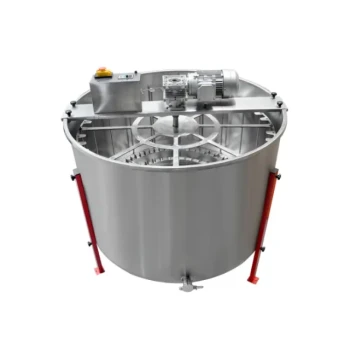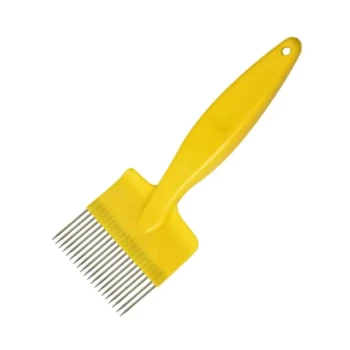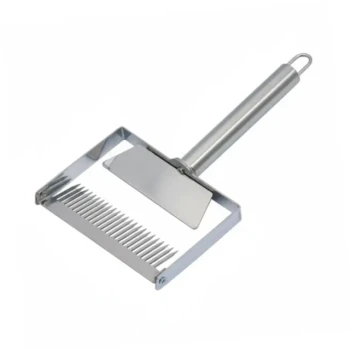In principle, a responsible beekeeper extracts only the surplus honey. This typically amounts to about one-third of the total honey stored in the hive, leaving the remaining two-thirds as the essential food source for the bee colony, especially during the colder months when foraging is not possible.
The core principle of honey harvesting is not extraction, but stewardship. A beekeeper's primary goal is to ensure the colony's health and survival, and a sustainable honey yield is the natural result of that healthy partnership.
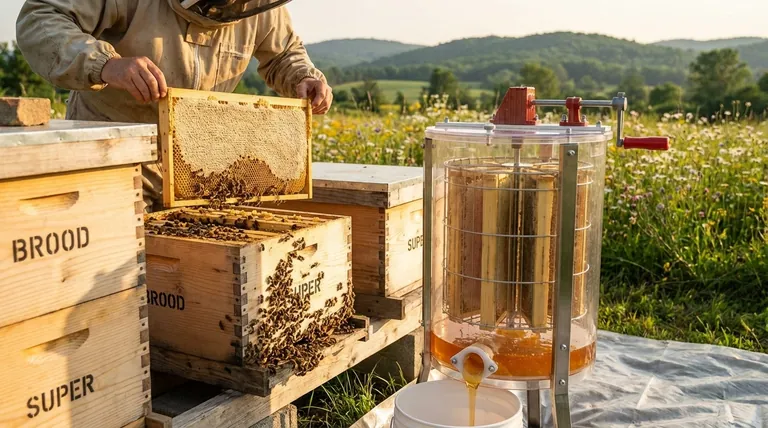
The Principle of Sustainable Harvesting
Understanding why a certain amount is harvested is more important than the specific quantity. The decision is based on a deep respect for the colony's needs.
Why Bees Need Their Honey
Honey is the lifeblood of a bee colony. It is their primary source of carbohydrates, providing the energy needed for all hive activities, from foraging and raising young to generating heat to survive the winter.
Taking all of a colony's honey would lead to its starvation and collapse. The beekeeper’s role is to manage the hive in a way that encourages the bees to produce a surplus beyond their own needs.
The 'One-Third' Rule of Thumb
The guideline to harvest about one-third of the honey is a general rule. The actual amount is a judgment call based on several factors, including the strength of the colony, the local climate, and the length of the winter.
In regions with long, cold winters, a beekeeper might leave even more honey. For a new or weaker colony, a responsible beekeeper may not harvest any honey at all, allowing the bees to use all their resources to build strength for the following year.
The Mechanics of Identifying and Extracting Surplus
A beekeeper doesn't just take honey from anywhere in the hive. The process is deliberate and designed to minimize disruption and maximize sustainability.
Identifying Ripe, Surplus Honey
Beekeepers use a multi-box hive system. The lower boxes, known as brood boxes, are where the queen lays eggs and the colony raises its young. The honey in these boxes is considered the bees' essential food and is not harvested.
The boxes placed on top, called honey supers, are where bees store surplus honey. A beekeeper only harvests from these supers once the honey is "ripe." This is identified when the bees have capped the honeycomb cells with wax, a sign that the honey has the correct moisture content and will not ferment.
The Extraction Process
The process involves removing frames of capped honey from the supers. The thin wax capping is then carefully scraped off, and the frames are placed in a honey extractor. This device uses centrifugal force to spin the honey out of the comb without damaging the comb itself.
Returning the Comb
Crucially, after the honey is extracted, the empty combs are returned to the hive. This is a massive energy-saver for the bees, as they do not have to expend resources rebuilding the wax structure from scratch. They can immediately begin refilling the returned combs with new nectar.
Understanding the Trade-offs
A beekeeper's judgment has direct consequences for the hive's health and productivity.
The Danger of Over-harvesting
The most significant risk is taking too much honey. This can weaken the colony, making it vulnerable to disease and pests. In the worst case, it leads to starvation over the winter and the complete loss of the colony.
The Risk of Under-harvesting
Leaving too much honey can also cause issues. A hive can become "honey-bound," meaning the combs are so full of honey that there is no space for the queen to lay eggs. This can restrict colony growth and may trigger the hive to swarm, where the queen and a large portion of the bees leave to find a new home.
Making the Right Choice for Your Goal
Harvesting honey is a decision that balances the needs of the bees with the goals of the beekeeper.
- If your primary focus is colony survival: Be conservative. Prioritize leaving more than enough honey for winter, especially for new hives or in harsh climates.
- If your primary focus is a sustainable yield: Adhere to the principle of taking only the true surplus from the honey supers after the bees have stored enough for themselves.
- If your primary focus is ethical beekeeping: View the bees' needs as paramount. Harvesting is a privilege granted by a thriving, healthy colony, not a right.
Ultimately, a successful beekeeper acts as a steward, ensuring the colony thrives first and foremost.
Summary Table:
| Harvesting Principle | Key Consideration | Typical Outcome |
|---|---|---|
| Sustainable Harvest | Extract only surplus honey, leaving the colony's core food supply. | Harvest ~1/3 of total honey; leave 2/3 for the bees. |
| Colony Health | Assess colony strength, local climate, and winter length. | Strong colonies in good seasons yield more surplus. |
| Harvesting Mechanics | Only take capped honey from 'honey supers,' not 'brood boxes.' | Ensures honey is ripe and minimizes disruption to the colony. |
Ready to harvest honey sustainably and keep your colonies thriving?
At HONESTBEE, we supply commercial apiaries and beekeeping equipment distributors with the high-quality, wholesale-focused supplies needed for successful, large-scale operations. From durable honey extractors to essential hive components, our equipment supports the efficient and ethical practices outlined in this guide.
Contact our expert team today to discuss how our products can help you maximize your sustainable honey yield and ensure the long-term health of your bee colonies.
Visual Guide
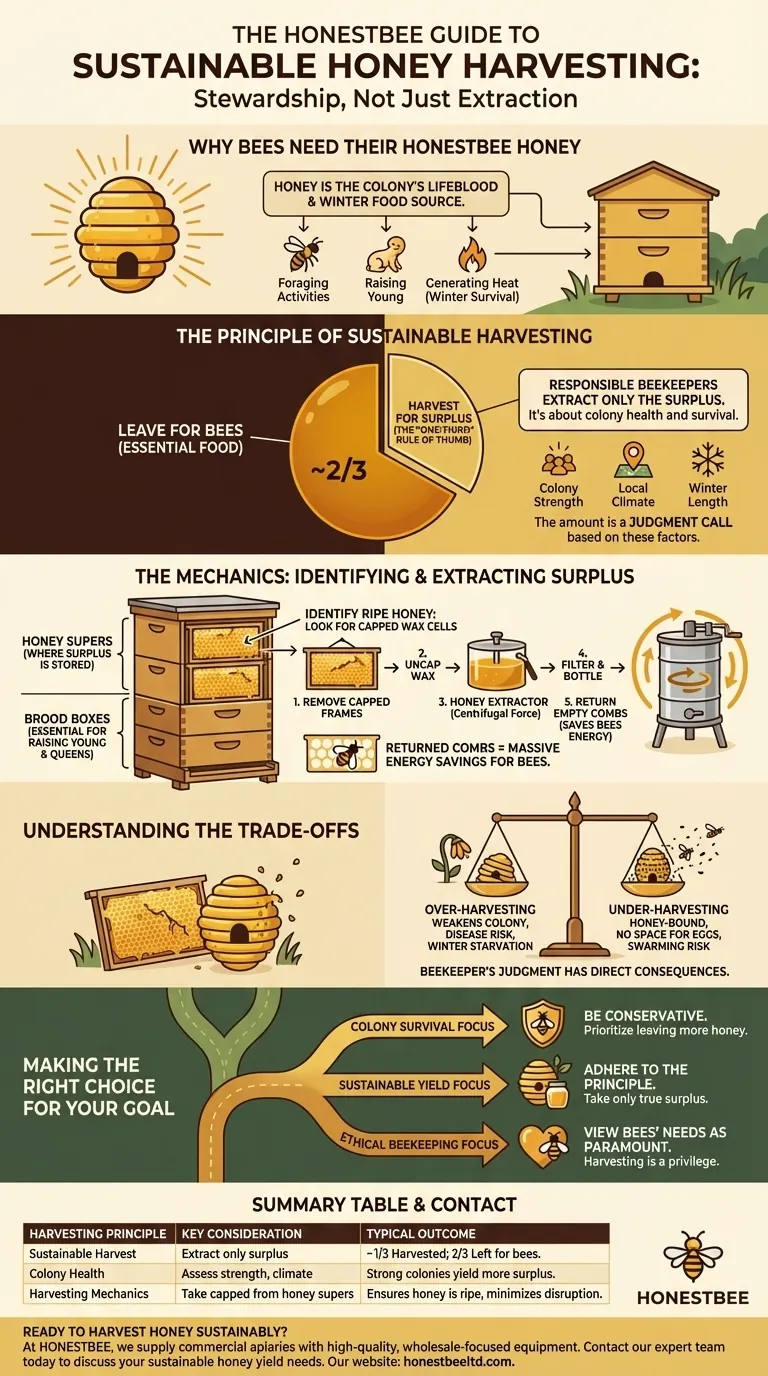
Related Products
- HONESTBEE 3-Frame Manual Acrylic Honey Extractor
- Electric 8 Frame Honey Spinner Extractor Equipment for Beekeeping
- Stainless Steel 3 Frame Manual Honey Extractor Spinner for Bee Honey Extraction
- 8-Frame Electric Self-Reversing Honey Extractor Spinner for Commercial Honey Extraction Equipment
- electric honey extractor honey centrifuge 3 frame honey extractor stainless steel honey frame extractor
People Also Ask
- What is a fun and easy alternative to using a honey extractor for harvesting honey? Try the Crush and Strain Method
- What is the most common method for cleaning a honey extractor? Protect Your Honey & Equipment
- What equipment is used for honey harvest? Essential Tools for Every Beekeeper
- Which type of honey extractor is generally more durable? Focus on Material & Build Quality for Longevity
- How often do beekeepers collect honey? Maximize Your Hive's Sustainable Yield








